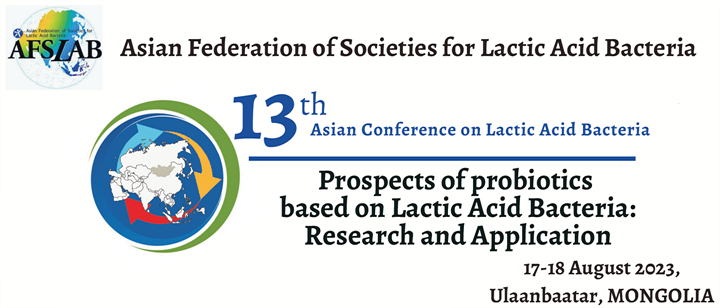The DairyCultures Team is presenting at the upcoming 13th Asian Conference on Lactic Acid Bacteria: Prospects of Probiotics Based on Lactic Acid Bacteria, Ulaanbaatar, Mongolia, August 16-18, 2023.

Abstract:
The impact of dairy-based diets on the gut microbiome: a view from Mongolia
Christina Warinner1,2,3, Sabri Bromage4,5, Alexander Hübner1, Yi Jia Liow6, Raphaela Stahl1, Lkhamsuren Khulan7, Nyambal Tuul7, Davaalkham Dambadarjaa7, Soninkhishig Tsolmon8
1 Max Planck Institute for Evolutionary Anthropology
2 Department of Anthropology, Harvard University
3 Leibniz Institute for Natural Product Research and Infection Biology Hans Knöll Institute
4 Institute of Nutrition, Mahidol University
5 Harvard T. H. Chan School of Public Health, Harvard University
6Department of International Health, University of Tokyo
7 School of Public Health, Mongolian National University of Medical Sciences
8 Graduate School of Business, Mongolian University of Science and Technology
Email address: warinner@fas.harvard.edu
Introduction: Human diet has radically changed since the emergence of our species approximately 200,000 years ago. Milk is a nutrient-dense food consumed by humans for thousands of years. The main carbohydrate in milk is lactose, a disaccharide of glucose and galactose that requires the action of a specific enzyme, lactase, to digest. The diet-related genetic variant lactase persistence (LP) arose to high frequency in certain Eurasian and African populations between 4,000 and 1,000 years ago, and it is one of the genomic features under highest selection in the human genome. Although the evolutionary context of dairy digestion is partly known, its microbial correlates within the human microbiome are less explored. Mongolia has a long prehistory of dairying that can be traced back 5,000 years ago to the Early Bronze Age, and there is a rich recorded history of dairying in Mongolia that includes numerous references to dairy livestock (sheep, goat, cattle, and horses) and specific dairy products. In rural Mongolia, dairy foods sustain and support the livelihood of herders year around and can make up to 50% of calories consumed during the summer. Specific dairy practices exhibit remarkable continuity through time, with relatively few changes compared to early 20th century ethnographic accounts. Today, tradition, cultural heritage, and a strong connection to the past is highly valued by Mongolian dairy herders. Here we discuss human adaptations to lactose consumption in Mongolia, and show that far from being simple, it involves a complex interplay between the host genome, the microbiome, and culinary practices. Using direct molecular evidence from the archaeological record and from nomadic dairy pastoralists living today, we discuss human dietary adaptation and argue that only by investigating the host genome, the microbiome, and cultural practices in tandem can human evolution, biology, and health be fully understood.